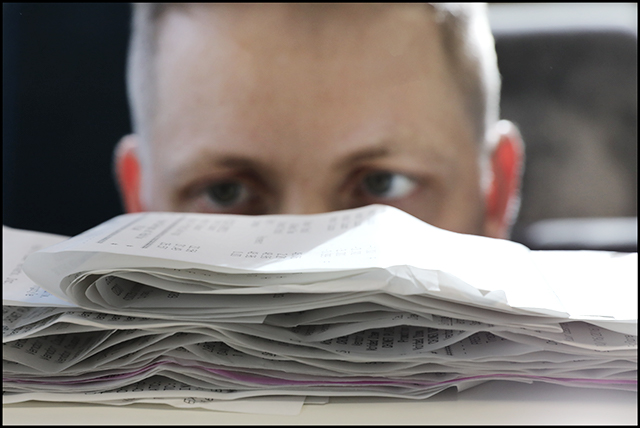Here’s How to Start Extreme Couponing Without Getting Overwhelmed

The Penny Hoarder assistant editor Justin Cupler and his wife, Rissti, spend about an hour and a half planning for most grocery shopping trips.
I could spend that time watching one-third of a season of “Broad City.” But, after just a short time sitting next to Cupler at our office, I started to get the feeling he could teach me something. This guy loves to save money.
Over the past few years, the couple have honed their couponing skills. Together, they’ve reduced their grocery budget to $300 per month for their family of four — and they aren’t living on prepackaged, preservative-filled foods.
I asked Cupler for his best extreme-couponing tips for beginners. Turns out, they’re not that extreme, so put aside your reality-show notions of getting $2,000 worth of groceries for a penny.
How to Start Extreme Couponing
Real extreme couponing only requires a blend of common sense, shopping savvy and organization. And getting started is easy.
1. Gather Your Supplies

If you want to use coupons here and there, skip this step.
But if you want to elevate your game to extreme coupon clipping, don’t rely on your ordinary inkjet printer. Cupler recommended investing in a laser printer to take advantage of the multitude of coupons you can find online and print at home.
Not only do toner cartridges last significantly longer than inkjet cartridges, but it’s also easier to buy remanufactured units that can save you up to 75% on the cost of ink. Laser-printer prices start at about $75, but you’ll make it back in grocery savings before you know it.
Then, think smart about paper. “A laser printer cuts down on the cost of paper because it’s better at feeding through smaller pieces of paper,” Cupler said. You can print about three to four coupons per sheet of paper, if you cut carefully.
But don’t just grab the first ream of paper you see at the office-supply store. Look for deals and rebates on cases of copy paper that typically cost $25 to $50.
Cupler looks for “buy one, get one for a penny” deals on cases of paper that work great if you’re willing to pay up front and wait for a rebate check.
Not ready to stock up that much? Look for office-supply store-brand rebates that bring the price of one case of paper to about $15. Those 5,000 sheets of paper will last you a long time.
Cupler has one more paper trick that blew my mind and made my environmentalist heart swell: Print coupons on your junk mail. Instead of throwing out your junk mail unopened, take out any pages that are only printed on one side.
“Grocery stores don’t care if there’s writing on the back of a coupon,” Cupler said, “as long as the barcode scans.”
2. Grab Competitor Coupons

While evaluating competitor coupons used to mean taking the time to comb through newspaper circulars, the internet has come to your rescue.
Some stores advertise that they accept competitor coupons; others don’t advertise it because it’s only available in certain markets. Figuring out your local stores’ policies is as easy as asking at the customer service counter.
“Always check online first for competitor coupons,” Cupler advised. Some stores are stingy about which coupons they put online, but you might be surprised to learn that even high-end grocery chains such as Whole Foods do it.
Finding coupons online is fairly simple, and the selection can be overwhelming! Cupler likes Couponaholic and Krazy Coupon Lady; I like Coupon Mom; other Penny Hoarders we work with might swear by Coupons.com or Red Plum.
Once you find a few sites you like, stick with them and don’t go loopy trying to find all the deals. If you spend too much time looking for coupons, the overall value of your savings will go down.
Consider what your time is worth before you start clipping (electronically or literally).
3. Stack Your Deals

Deal stacking multiplies your savings by combining discounts from manufacturers, stores, competitors and rebate apps. It’s the best way to save the most money, but it can also be risky.
“Don’t be afraid to try a coupon you’re not sure will work,” Cupler said. He recalled being pleasantly surprised when a grocery store accepted his drug-store catalina coupon.
“If it doesn’t work, you learned a lesson,” he said. If you really want the product, you just save less on it. Or, you can simply tell the cashier you’d like to skip purchasing that item.
You can stack deals the most on new products, in Cupler’s experience, so it’s helpful to explore and be willing to try new things.
“You can’t have brand loyalty” and expect couponing success, Cupler warned, when you’re trying to stack the most extreme coupons. “Be willing to mix up brands, but stick with the quality you’re comfortable with.”
4. Do the Math

Using a coupon here or there can feel good, but making a list and doing some math before you hit the store can help you determine how much you can save — and if your shopping list truly fits your grocery budget.
If you do your homework, you’ll be better prepared to evaluate your success. Cupler recommended taking a few moments to review once you get home with your haul. Did you make any mistakes or learn any lessons? Did your total come to what you expected to spend?
“If you’re off by more than a dollar, something’s off,” Cupler said. Check your receipt against your initial math to learn how to save in the future.
If your total is way off, check that the cashier didn’t miss any of your coupons. They are human and sometimes miss one or two!
Many stores have no problem adding the coupon after the sale is complete and refunding you the value of the coupon. Simply stop by the customer service desk and ask for help.
5. Get Organized (and Be Nice)

A few housekeeping tips before you head to the store:
- Do not gear up for your grocery trip by watching Extreme Couponing. That show is not reality, says Cupler.
- Read and understand the coupon policy at every store you visit. “Print it out and carry a copy of that policy with you,” Cupler said. They’re usually written in plain English, and can help make sure you save every penny possible should you encounter a new cashier or one who’s having a bad day.
- Get organized before you get to the register. Find an empty aisle of the store to sort through your coupons and check your list. Every cashier has a different system for scanning coupons, so your only rule here is to be observant and ask if you don’t see something scan through properly.
- Don’t look for the shortest line at checkout. Instead, find the friendliest face — someone who looks like they enjoy interacting with customers.
- Be respectful of other customers. “If someone has five things in their basket, let them go ahead of you,” Cupler advised. “The last thing you want is the person behind you glaring at you.”
6. Don’t Sweat Your Mistakes Too Much

Learning how to do extreme couponing will not net you a 2-cent grocery bill on your first attempt (or maybe ever).
“When we first started out, we had four newspaper subscriptions” to get all the coupon inserts and circulars, Cupler said. “Then we figured out we could get it all online.”
Ready to get started?
“Start small and make mistakes,” he said. He still messes up after years as an “extreme” couponer.
“Don’t be afraid to try something and screw up and learn from it. Start with four or five products, do the math and see how it goes.”
Your Turn: Are you an extreme couponer? What strategies do you use to get the best deals?
Lisa Rowan is a writer and producer at The Penny Hoarder.


















